Ragnarok becomes Pie, The Joys of 2RU
1.5GB of memory was more than adequate in Thor, so we continued with that amount in the new server. PlusCorp recommended Kingston ValueRAM ECC Registered DDR266. This is based on Samsung chips and is as fast as our motherboard will support, so three 512MB sticks is ideal.

Finally, we built the server into Antec's 4U22ATX 4RU rackmounted case (a reader reviewed one here.) This is a really plush case, with rubber-mounted hard drive cages and lots of other nice build-quality touches. 4RU gives us a lot more freedom in terms of using standard PC components than squeezing down into a 2RU or 1RU case. I was also concerned about using four hard drives - and cooling them properly - in a smaller case. Thor was currently in a generic 4RU and we planned to swap the two boxes over, so size didn't seem to be an issue. PlusCorp provided all the miscellaneous components we needed including a CDROM, floppy drive (both with black faceplates to match our case!), SCSI cabling etc.
In case you're not familiar with what "4RU" means - it refers to rack-mounted equipment. One "rack unit" or RU is about 1.75 inches high. A 4RU case is four times that in vertical height, and you can get equipment in anything from 1RU to a full 48RU or more. Later in this article you'll see a 2RU and 1RU case in action.
Building a PC into a generic 4RU case is essentially the same as building one into a full-tower case lying on its side, except the drives and PSU are oriented differently. Really, there's not much to it, and as we didn't end up using this case for reasons explained below, I'll spare you the step-by-step description. Here's a few pics I took along the way:
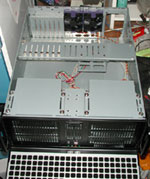 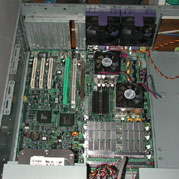 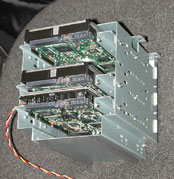
Apart from some cable tidying we were ready to go. Also not shown in the picture below is the IDE drive, which hangs from a cage attached to a rail running across the width of the case - you can see the mounting holes for the rail in the picture.
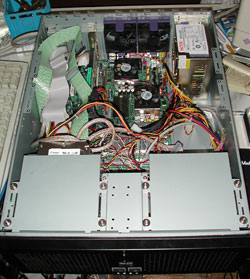
Ragnarok becomes Pie
So, we now had a large black monster named Ragnarok in accordance with my existing Viking-inspired naming scheme. Ragnarok is the end of the world in Norse mythology, but depending who you ask it is usually considered as an event that has already happened, resulting in the creation of the current world of Man. This seemed appropriate enough for the new "world" that OCAU would live in, but the name was unwieldy, too long to type and everyone kept getting it wrong. :)
Unfortunately at this point, AusGamers, who host OCAU, were reorganising their hosting arrangements with Comindico, so there were a few months where the project stalled while we waited for the green light to send the server to them. During this time a few things happened. Firstly, AusGamers indicated that 4RU was undesireable in terms of the rackspace it took up, and perhaps we could move to a 2RU case. It was decided that we could run two 2RU boxes if we liked, in the 4RU space that Thor was taking up. This is ideal, because it would allow us to further separate the roles of webserver and database server. I decided then to change the naming scheme. Comments from OCAU readers made me think about a more Australian naming scheme and one that would work with our plans for a second server. In accordance with this, Ragnarok was renamed pie, and Thor, once rebuilt as a dedicated webserver, would be renamed sauce.
The plan was to quickly rebuild pie into a 2RU case and send it to AusGamers, who had now resolved their hosting concerns. Then, Thor would be returned to me, rebuilt into a 2RU case and sent back out to continue work as "sauce", the new web-only server. Pie was still ideal for the SQL server and could also do webserver work if required. So, I needed to quickly find a 2RU case that met our needs, but it wasn't easy. Firstly, the Tyan dual socketA motherboard is Extended ATX format, significantly wider than a standard ATX case allows. We also need to fit our special EPS PSU into the case. Finally, we need to use - and cool - our four hard drives. The RAID array of two 15k-rpm drives won't last long if not actively cooled. I found a Maxtop 2RU case which on paper seemed to meet our needs. PlusCorp had one sent directly to us and I began the work of rebuilding Ragnarok, now called pie, from the 4RU case into the new 2RU one.
The Joys of 2RU
2RU is actually a fairly handy size. A normal ATX PSU will fit inside the case and the stock MP2800+ CPU coolers have enough free air above them to work properly. Of course, once you start squeezing things into small spaces, it's not always plain sailing. Airflow is a primary concern as it's easy to get hotspots in these wide flat cases if you don't keep the air moving through them. However, unlike a desktop PC, noise isn't really a concern because the server is in a computer room full of other loud machines and powerful air conditioning etc.
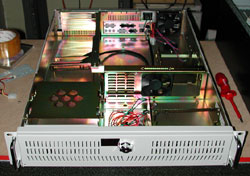
Unfortunately the Maxtop turned out to not be as plush a case as the Antec, and there were some difficulties. The first problem was the PSU. The case included a PSU mounting plate, but it simply didn't work with our PSU. Without the plate the PSU fit, yes - but only JUST - the fan grille had to be removed or the case wouldn't shut. Also, the top fan was sucking directly against the top lid of the case. This is obviously not ideal and will kill the fan bearings in no time, not to mention the PSU is not getting the cooling it needs. This isn't the fault of the case, and there are plenty of PSUs without bottom-mounted fans, instead having a more flow-through design from front to back, but we wanted to use this Maxtop EPS unit if possible.
Finally, the odd-looking front mounting position for the PSU, while a common-enough arrangement in 2RU cases, meant the exhaust fan was working against the front-to-back airflow plan for this case. After pondering this for a while, I decided warranties are for wimps and pulled the PSU apart. First to go was the top-mounted fan. Secondly, I reversed the exhaust fan so it became an intake fan. Mounting the PSU upside down prevented anyone from dropping anything into the PSU (like, their fingers) with the top fan and grille removed. Finally, on the side of the PSU facing the front of the case (opposite to the normally exhaust, now intake, fan) I mounted a fan blowing onto the drive bay where the RAID array will be. This isn't directly mounted on the PSU, but will encourage hot air from the PSU to draw through the ventilation holes, be blown over the RAID array and exit via the exhaust fan on the rear of the case. The standard PSU mounting hardware was discarded. This arrangement seems to work well, with the PSU and RAID array keeping cool even under heavy load. Finally, I made a warning label and stuck it to the visible part of the PSU, to alert any technicians (or myself, in the future when I've forgotten) that the PSU is not sealed on the bottom, so to disconnect mains power before moving it. There's no risk of a short, of course, but you could accidently put a finger inside it if you weren't careful.
|


